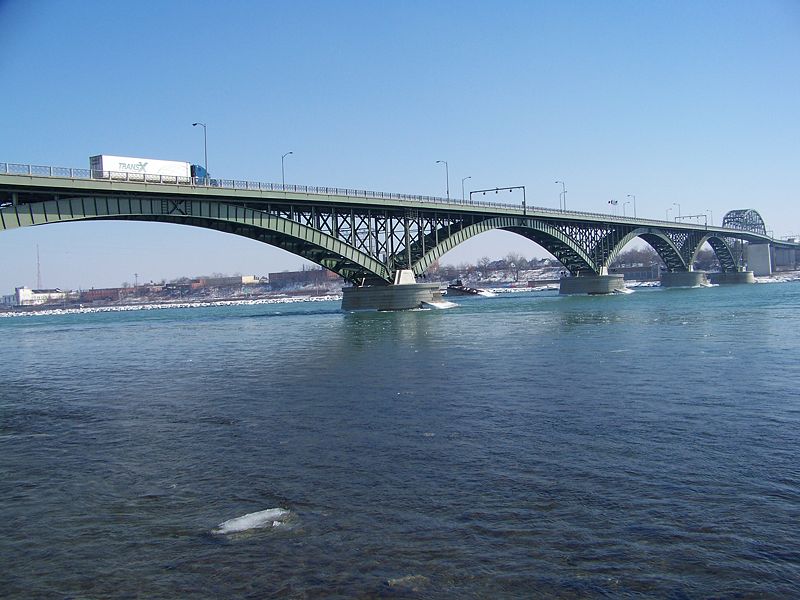Peace Bridge
The Peace Bridge is an international bridge between Canada and the United States at the east end of Lake Erie at the mouth of the Niagara River, about 20 kilometres (12.4 mi) upriver of Niagara Falls. It connects the City of Buffalo, New York and the Town of Fort Erie, Ontario. It is operated and maintained by the Buffalo and Fort Erie Public Bridge Authority.

Peace Bridge
Crosses Niagara River
Locale Fort Erie, Ontario and Buffalo, New York
Design Truss and arch bridge
Total length 5,800 feet (1,768 m)
Opening date June 1, 1927
The Peace Bridge consists of five arched spans over the Niagara River and a Parker through-truss span over the Black Rock Canal on the American side of the river. The total length is 5,800 feet (1,768 m). Material used in the construction included 3,500 feet (1,067 m) of steelwork, 9,000 tons of structural steel and 800 tons of reinforcing steel in the concrete abutments. The Peace Bridge was named to commemorate 100 years of peace between the United States and Canada. It was constructed as a highway bridge to address the needs of pedestrian and motor vehicle traffic which could not be accommodated on the International Railway Bridge, built in 1873. The building of the Peace Bridge was approved by the International Joint Commission on August 6, 1925. A major obstacle to building the bridge was the swift river current, which averages 7.5 to 12 miles per hour (19 km/h). Construction began in 1925 and was completed in the spring of 1927. On June 1, 1927 the bridge was opened to the public. The official opening ceremony was held two months later, on August 7, 1927, with approximately 100,000 in attendance. The festivities were transmitted to the public via radio in the first international coast-to-coast broadcast. Newspapers at the time estimated as many as 50 million listeners may have heard the broadcast. The dignitaries who took part in the dedication ceremonies included Edward, Prince of Wales (the future Edward VIII), Prince Albert, Duke of York (the future George VI), Canadian Prime Minister William Lyon Mackenzie King, British Prime Minister Stanley Baldwin, U.S. Vice President Charles Dawes, Secretary of State Frank Kellogg, New York Governor Al Smith and Ontario Premier Howard Ferguson. When the bridge opened, Buffalo became the chief port of entry to Canada from the United States. At the time it was the only vehicular bridge on the Great Lakes from Niagara Falls to Minnesota. The bridge remains one of North America's important commercial ports - four thousand trucks cross it daily. The Buffalo and Fort Erie Public Bridge Authority in 1997 announced plans for the building of a second bridge south of and beside the existing Peace Bridge. It was expected that the new Peace Bridge would alleviate traffic congestion and increase daily vehicle traffic by at least 33%. Legal challenges as well as concerns about the design and how costs will be paid delayed the start of construction. While the Jury Recommendation Report originally recommended a cable-stayed bridge "signature bridge" for the new span, the option was over-ruled in favour of a more conventional design due to concerns that endangered birds would possibly fly into the bridge. Local authorities are appealing the decision. Other nearby bridges between the United States and Canada include the Rainbow Bridge, the Queenston-Lewiston Bridge and the Whirlpool Rapids Bridge. The Queenston-Lewiston Bridge and the Peace Bridge are the only crossings that allow heavy trucks. On the New York side, Interstate 190 has a direct northbound off-ramp (Exit 9) onto the Peace Bridge. This exit is signed as Ft. Erie Can on I-190, but the bridge is actually Baird Drive. Baird Drive is not signed on the exit, but the road does head south of the bridge to its southern terminus of Porter Avenue. On the Ontario side, the Queen Elizabeth Way begins after Canadian Customs. After new toll facilities were installed on the Canadian side in 2005, the Peace Bridge became the first (and at present the only) E-ZPass facility outside the United States.